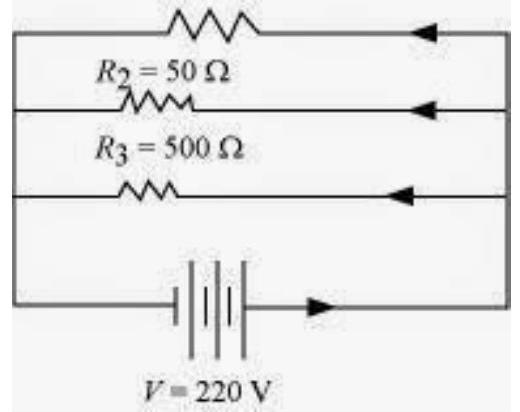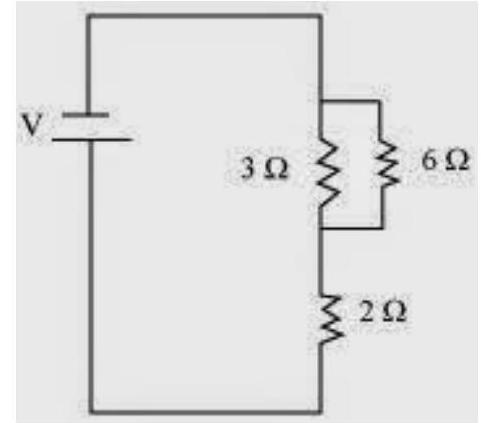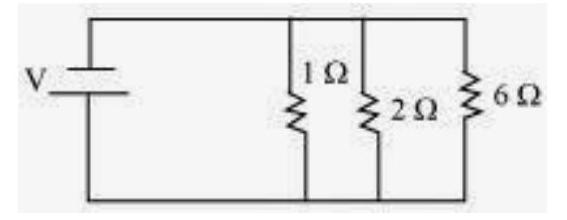Chapter 11 Electricity Questions-05
QUESTIONS
1. Judge the equivalent resistance when the following are connected in parallel - (a) $1 \Omega$ and $10^{6} \Omega$, (b) $1 \Omega$ and $10^{3} \Omega$, and $10^{6} \Omega$.
Show Answer
Answer
(a) When $1 \Omega$ and $10^{6} \Omega$ are connected in parallel:
Let $R$ be the equivalent resistance.
$ \begin{aligned} & \therefore \dfrac{1}{R}=\dfrac{1}{1}+\dfrac{1}{10^{6}} \\ & R=\dfrac{10^{6}}{1+10^{6}} \approx \dfrac{10^{6}}{10^{6}}=1 \Omega \end{aligned} $
Therefore, equivalent resistance $\approx 1 \Omega$
(b) When $1 \Omega, 103 \Omega$ and $106 \Omega$ are connected in parallel:
Let $R$ be the equivalent resistance.
$ \begin{aligned} & \dfrac{1}{R}=\dfrac{1}{1}+\dfrac{1}{10^{3}}+\dfrac{1}{10^{6}} \dfrac{10^{6}+10^{3}+1}{10^{6}} \\ & R=\dfrac{1000000}{1001001}=0.999 \Omega \end{aligned} $
Therefore, equivalent resistance $=0.999 \Omega$
2. An electric lamp of $100 \Omega$, a toaster of resistance $50 \Omega$, and a water filter of resistance $500 \Omega$ are connected in parallel to a $220 V$ source. What is the resistance of an electric iron connected to the same source that takes as much current as all three appliances, and what is the current through it?
Show Answer
Answer
Resistance of electric lamp, $R_1=100 \Omega$
Resistance of toaster, $R_2=50 \Omega$
Resistance of water filter, $R_3=500 \Omega$
Potential difference of the source, $V=220 V$
These are connected in parallel, as shown in the following figure. $R_1=100 \Omega$

Let $R$ be the equivalent resistance of the circuit. $\dfrac{1}{R}=\dfrac{1}{R_1}+\dfrac{1}{R_2}+\dfrac{1}{R_3}=\dfrac{1}{100}+\dfrac{1}{50}+\dfrac{1}{500}$
According to Ohm’s law,
$V=I R$
$I=\dfrac{V}{R}$
Where,
Current flowing through the circuit $=I$
$I=\dfrac{220}{\dfrac{500}{16}}=\dfrac{220 / 16}{50}=7.04 A$
7.04 A of current is drawn by all the three given appliances.
Therefore, current drawn by an electric iron connected to the same source of potential $220 V=7.04 A$
Let $R^{\prime}$ be the resistance of the electric iron. According to Ohm’s law,
$V=I R^{\prime}$
$R^{\prime}=\dfrac{V}{I}=\dfrac{220}{7.04}=31.25 \Omega$
Therefore, the resistance of the electric iron is $31.25 \Omega$ and the current flowing through it is $7.04 A$.
3. What are the advantages of connecting electrical devices in parallel with the battery instead of connecting them in series?
Show Answer
Answer
There is no division of voltage among the appliances when connected in parallel. The potential difference across each appliance is equal to the supplied voltage.
The total effective resistance of the circuit can be reduced by connecting electrical appliances in parallel.
4. How can three resistors of resistances $2 \Omega, 3 \Omega$, and $6 \Omega$ be connected to give a total resistance of (a) $4 \Omega$, (b) $1 \Omega$ ?
Show Answer
Answer
There are three resistors of resistances $2 \Omega, 3 \Omega$, and $6 \Omega$ respectively.
(a) The following circuit diagram shows the connection of the three resistors.

Here, $6 \Omega$ and $3 \Omega$ resistors are connected in parallel.
Therefore, their equivalent resistance will be given by
$ \dfrac{1}{\dfrac{1}{6}+\dfrac{1}{3}}=\dfrac{6 \times 3}{6+3}=2 \Omega $
This equivalent resistor of resistance $2 \Omega$ is connected to a $2 \Omega$ resistor in series.
Therefore, the equivalent resistance of the circuit $=2 \Omega+2 \Omega=4 \Omega$
Hence the total resistance of the circuit is $4 \Omega$.
(b) The following circuit diagram shows the connection of the three resistors.

All the resistors are connected in series. Therefore, their equivalent resistance will be given as
$ \dfrac{1}{\dfrac{1}{2}+\dfrac{1}{3}+\dfrac{1}{6}}=\dfrac{1}{\dfrac{3+2+1}{6}}=\dfrac{6}{6}=1 \Omega $
Therefore, the total resistance of the circuit is $1 \Omega$.
5. What is (a) the highest, (b) the lowest total resistance that can be secured by combinations of four coils of resistance $4 \Omega, 8 \Omega, 12 \Omega, 24 \Omega$ ?
Show Answer
Answer
There are four coils of resistances $4 \Omega, 8 \Omega, 12 \Omega$ and $24 \Omega$ respectively.
(a) If these coils are connected in series, then the equivalent resistance will be the highest, given by the sum $4+8+12+24=48 \Omega$
(b) If these coils are connected in parallel, then the equivalent resistance will be the lowest, given by
$ \dfrac{1}{\dfrac{1}{4}+\dfrac{1}{8}+\dfrac{1}{12}+\dfrac{1}{24}}=\dfrac{1}{\dfrac{6+3+2+1}{24}}=\dfrac{24}{12}=2 \Omega $
Therefore, $2 \Omega$ is the lowest total resistance.










